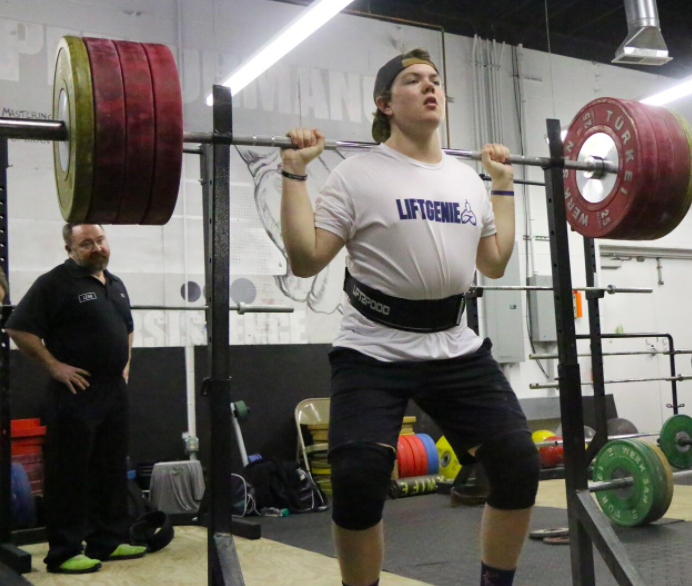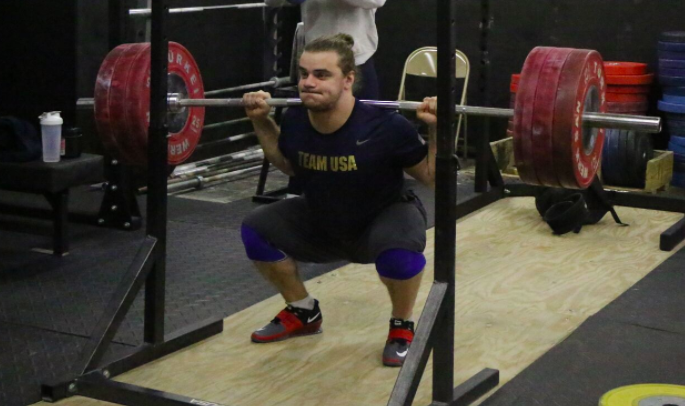Man, people have so many opinions about whether or not athletes should max out. Strength coaches along with all of the internet ‘experts’ discuss this topic frequently, and they relate it to all lifts. Today I am mainly discussing the back squat because it is so important to the main sports that I work with namely Olympic weightlifting and football. The back squat allows weightlifters to gain the strength needed to improve in their competitive lifts, and it allows them to improve upon the positions and mobility needed to perform their main lifts of the snatch and clean & jerk.
The back squat is more closely related to improvements in the vertical leap and 40-yard dash than the clean, and that’s coming from a Team USA Head Weightlifting Coach. Coach Bryan Mann who set out to prove that the clean was superior informed me of that research. If you are coaching a sport, the squat needs to be a part of the program. We can debate the Olympic lifts if you want. However, I don’t think that the squat is up for debate. Then again, I guess you can do whatever you want, but if you want superior results, the squat should be a part of that program.
[thrive_leads id=’9126′]
Should a squat one-repetition maximum always be tested? I haven’t seen any concrete research to state one way or the other, but here are some of my thoughts based on coaching thousands of athletes over the last twenty plus years. First, I want to clear up the three-repetition maximum versus the one-repetition maximum debate. This one is up to the coach, but my thoughts are that the three-repetition maximum is more dangerous than a straight up one-repetition maximum. Here’s why:
It’s easier to stay focused for one-repetition versus a three-repetition maximum. Here’s another thing: most athletes can perform 90-95% of their 1RM for three. Do you really think 5-10% is the difference maker versus safety? If an athlete squats 400 pounds, are you telling me that 360-380 pounds is easier on the body and less dangerous than 400 pounds? Any athlete that has ever lifted a weight would disagree. It’s much easier to stay tight and focus on positions with one heavy repetition versus grinding out that third repetition under fatigue.
With that being said, I propose that there might be a way to test strength improvements in the back squat without performing a one repetition maximum or a three-repetition maximum, and that’s with velocity. However, there are a few minimums that must be reached, so let’s look at them.
If you are a football player, most research and most of my go-to experts say that a one-repetition maximum of between 2 and 2.5 times bodyweight must be reached to allow for maximum results in the vertical leap and 40-yard dash. Once you’ve obtained a squat somewhere in that range, you will have all the strength required for maximum power output. Anything over that is added stress on the body with little in return regarding athletic performance.
Does that mean you should quit squatting? No way! It just means that absolute strength is no longer the main concern. At that point, the focus should shift to accelerative strength, strength speed, and speed strength. As a refresher, here is what these three strength qualities represent:
- Accelerative Strength- the velocity of this strength quality occurs somewhere between .5-.75 m/s and 70 to 90% of your one-repetition maximum. This is simply moving a heavy load as fast as possible.
- Strength Speed- the velocity of this strength quality occurs somewhere between .75-1.0 m/s and 50 to 65% of your one-repetition maximum. This is moving a moderately heavy weight as fast as possible.
- Speed Strength- the velocity of this strength quality occurs somewhere between 1.0-1.3 m/s and 30-45% of your one-repetition maximum. Here you are using light loads at very fast velocities.
These qualities of strength become way more important to athletics after a one-repetition maximum of 2 to 2.5 times bodyweight squat is reached. I would suggest testing overall programming improvements with weights in the accelerative strength ranges. I would pick somewhere between 80 to 90% of your one-repetition maximum and test it before a training block begins, and then test it again after the block. The goal is to move the same exact weight faster. Here’s an example:
- Max squat is 500 pounds
- 85% of 500 pounds is 425 pounds
- Beginning test is 425 pounds at .68 m/s
- End test is 425 pounds at .8 m/s
- That’s a significant increase and a win at over a 17% increase in velocity
That’s the safest and most effective way that I could imagine testing an athlete’s one-repetition maximum. It’s a heavy enough weight to elicit a decent response. It’s only one repetition, so maximum focus can be applied to the one repetition of the test. With this way of testing, results can be measured and safety is maximized.
What about Olympic weightlifting? I’d say that a case could be made for the same method of testing. However, only for athletes that far exceed normal strength ratios. Most experts agree that a weightlifter should squat 75% of their back squat. Does that mean all athletes should fall in that ratio to be considered technically sound? No way.
If you ever watch Nathan Damron perform the snatch or clean & jerk, you will see some of the most beautiful lifting of your life. He back squats 700 pounds and has a maximum clean & jerk of 206kg/454lb. This puts him at about 64.8% of his back squat in relation to his clean & jerk. Here’s the thing with lifters like Nathan: he is built to squat. He has the shortest femurs on earth, and he’s filled with fast twitch fibers. That is going to equate to a massive squat. This squat is not going to equal a 240kg clean & jerk in this case.
However, Nathan has a big enough squat to accomplish as heavy of a clean & jerk that his body is capable of. Does that mean he should quit squatting? No way! He needs to maintain that strength, and focus on strength qualities that might affect Olympic weightlifting more positively. At this point moving heavy loads as fast as possible is more important. In Nathan’s case, testing might look like this:
- Max Squat is 700 pounds
- 90% of 700 pounds is 630 pounds
- Beginning Test is 630 pounds at .55 m/s
- End Test is 630 pounds at .63 m/s
- That’s a significant increase and a win at over a 15% increase in velocity
Really in Nathan’s case, I would accept a 5-10% increase in velocity as a major win. Any improvement at all regarding his squat will mean that he is more than ready to make a big snatch or clean & jerk. A focus on velocity frees his joints of damage that is normally inflicted with massive squats. He can then put his focus on perfecting the snatch, clean & jerk, and strengthening his weak spots with pulls and overhead strength.
Thanks to guys like Coach Bryan Mann, we are no longer bound to heavy max out sessions in the squat to monitor results. There are several ways to measure an athlete’s performance increases with velocity-based training. Velocity might not be the tool that gets us clean & jerking world records and running 4.1-second 40-yard dashes, but it’s definitely a great tool for keeping our athletes safe in the weight room. If we help our athletes avoid injuries, that means they can continue getting better. I hope that this article helps all of you make some wiser decisions with your own athletes.
I am working on the Mash Squat Bible, and I will be talking more about this topic and more as it relates to the back squat. I’ve wanted to write this book for some time. Athletes have been coming to me for years to get strong, and now I am going to tell all of you how I do it. I will also tell you what the research supports, and what it doesn’t. Be on the outlook at the end of the month!
[thrive_leads id=’8207′]


